Antarctica's Lake Vostok
By Martin Siegert
Specialists in disciplines ranging from glaciology to engineering are preparing to explore the world's largest subglacial lake
Specialists in disciplines ranging from glaciology to engineering are preparing to explore the world's largest subglacial lake

DOI: 10.1511/1999.42.510
At the base of the Antarctic ice sheet, some 4 kilometers below the Russian Vostok research station, lies an accumulation of water about the size of Lake Ontario. This remote body, named Lake Vostok, is by far the largest subglacial lake in the world.
It persists despite surface temperatures that regularly hover around –60 degrees Celsius, because the bottom of the ice at this locale absorbs enough heat from the interior of the earth to keep the lake from freezing.
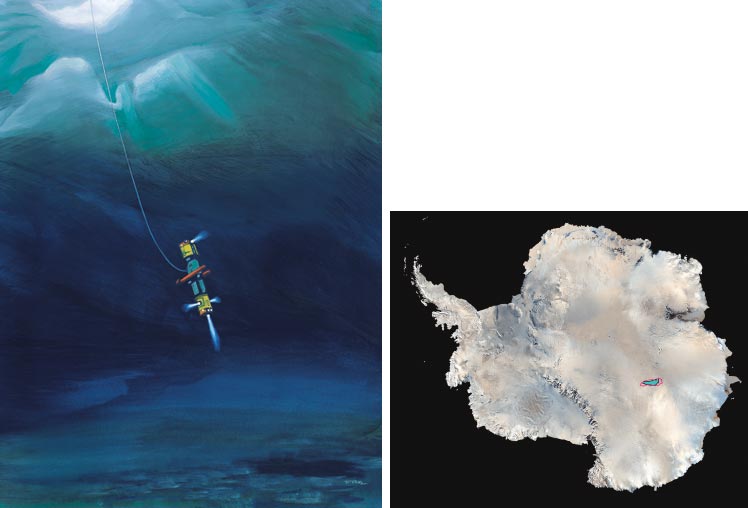
Conceptual design for the robot shown at left courtesy of Deep Ocean Engineering; false-color satellite image of Antarctica above courtesy of the U. S. Geological Survey.
Scientists estimate that the ice sheet above Lake Vostok has been in place for at least several million years and possibly as long as 15 million years. The origins of the lake may therefore date back across geological time to the Miocene epoch, when the Mediterranean was sometimes a desert and horses were about the size of collie dogs.
An ancient, ice-bound lake intrigues earth scientists for obvious reasons. Biologists, too, are quite interested, because they expect that the lake harbors microorganisms that may have entered at the time of formation and have since adapted to the extreme conditions reigning there—that is, to exceedingly low nutrient and energy levels. Because Lake Vostok has been completely isolated from the rest of the planet for at least several hundred thousand and perhaps several million years, the organisms within it must have undergone an independent course of evolution over this interval, perhaps resulting in life forms that are unique to this strange place.
So it is small wonder that plans are afoot to explore this and other subglacial lakes in Antarctica. Before such efforts can be mounted, however, glaciologists need to know more about the ice above the lake and about the rocks and sediment below it. To understand how my colleagues and I hope to gather this new information, it is useful to review how existing knowledge about the lake was obtained.
The history of discovery of Lake Vostok spans more than three decades and involves scientists from the United Kingdom, Russia, Denmark, France and the United States. The story also involves some people who are not scientists. In fact, the first mention of lakes within central Antarctica came from a Russian pilot named R. V. Robinson, who in 1961 spotted flat areas within the Antarctic ice sheet and described them as "lakes" with what he imagined to be "shorelines." Russian glaciologists must have been eager to set him straight at the time, but Robinson may indeed have unwittingly identified the surface manifestations of subglacial lakes several kilometers below.
Such deeply buried lakes, especially the large ones, cause the surface above them to remain level and smooth by a simple mechanism: There is no friction between the bottom of the ice sheet and the lake water, whereas there is plenty of friction between the ice and bedrock on either side. Thus horizontal frictional forces tend to buckle the slowly moving glacial ice where it grinds along on bedrock, making the surface rough and noticeably tilted. Areas of low friction—such as Lake Vostok—stand out because they make for conspicuously flat stretches. Robinson's scientific colleagues did not appreciate this principle of glaciology in 1961, and they made no attempt at the time to investigate what lay below his curious sightings.
Yet, just three years later, a team of Russian scientists, led by Andrei Kapitsa of Moscow State University, performed a seismic experiment over what is now known to be Lake Vostok. They chose the site simply because it was conveniently close to the Vostok research station, and by a happy coincidence, the station is situated directly over this body of water. Their seismic soundings were ideal for probing the subglacial lake, because compressional sound waves pass as well through water as they do through ice, and they reflect energy back from boundaries where there is a contrast in density. The two-way travel time of the reflected waves—the delay between the emitted sound pulse and its echoes—multiplied by the velocity of the waves yields a value equal to twice the distance to the boundary causing the reflection. Thus, seismic soundings can, in principle, measure the thickness of the ice, the depth of water within a subglacial lake and the accumulation of sediments at the bottom.
In practice, the reflections recorded in seismic experiments are often quite difficult to discern. In 1964, Kapitsa's team was interested only in knowing the thickness of the ice sheet and, not being aware of the huge lake below their feet, failed to recognize the subtle indications of a deeply buried body of water. Soon after the fieldwork ended, Kapitsa stored the record of this seismic study in his garden shed in Moscow, where, by sheer luck, it survived a fire that destroyed the small shack. The roll of seismic paper was so tightly coiled that the blaze only charred it at the edges, leaving the inked seismic traces for Kapitsa and his colleagues to re-examine three decades later.
One might wonder why more modern seismic soundings around Vostok station had not superseded Kapitsa's early experiment. The short answer is that few people attempt seismic measurement on the Antarctic ice sheet, because the upper 30 meters or so consist of snow that has not yet compacted into a firm solid. Seismic waves do not travel well through snow, which acts like a sound-proofing blanket. To obtain good results, one has to drill down at least 40 meters into dense glacial ice, where the seismic source (an explosive charge) and sensing apparatus (seismometers) can then be lodged. Thus, seismic investigations of ice sheets take considerable time and effort, and so this method is used only rarely to map the bedrock in Antarctica.
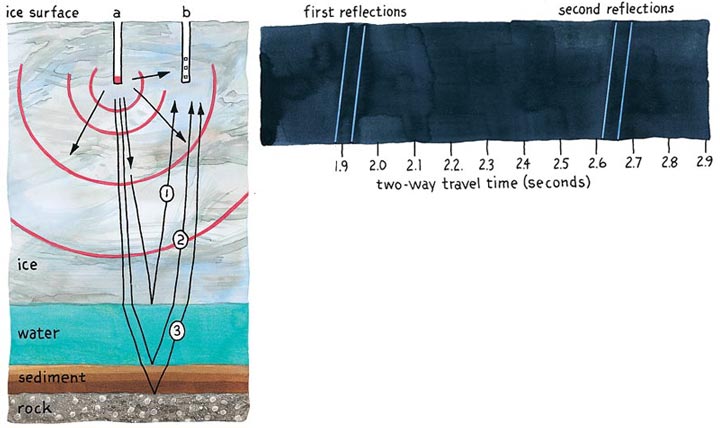
Tom Dunne
But seismic surveying is not the only way to detect a subglacial lake. During the 1970s, a tightly knit group of researchers from the U.S., U.K. and Denmark, led by Gordon Robin of the Scott Polar Research Institute at the University of Cambridge, performed a detailed radar sounding of the ice sheet. The radar apparatus Robin and his colleagues employed sent VHF radio waves down into the ice, where they reflected off layers of contrasting electrical properties. Such boundaries lie between internal layers of ice that have slightly different composition. The most significant discontinuity exists between the base of the ice and the underlying bedrock or, in the case of Lake Vostok, the underlying water.
As with seismic sounding, radar can be used to measure the thickness of ice by multiplying the two-way travel time by the velocity of the waves and halving the result. And by plotting side by side the reflections from consecutive radar pulses obtained while moving horizontally, glaciologists can generate a picture of the ice sheet in cross section. Because the necessary radar equipment can be mounted on an aircraft, they can record information along a flight line at a speed of about 300 kilometers an hour—making airborne radar a particularly efficient means of surveying a vast white wilderness.
Although it is sometimes difficult to discern the base of the ice sheet in a radar cross section, the signature of a subglacial lake is unmistakable. It contains distinct radar echoes from the interface between ice and water, which vary little in strength over a large distance. These signals form a telltale horizontal line marking the top of the water. In contrast, ice sitting on bedrock normally generates weak or variable reflections, which appear vague and undulating in a typical radar profile.
Gordon Oswald and Robin were the first to use airborne radar to uncover several small subglacial lakes in Antarctica, reporting their conclusions to the rest of the scientific community in 1973. Four years later, Robin and his colleagues noticed a large expanse of water in radar recordings obtained close to the Vostok Station, and so they dubbed the newly discovered body Lake Vostok.
Scientists interested in this and other subglacial lakes in Antarctica were, of course, pleased to have airborne radar added to their toolkit. But they were ecstatic to learn about another implement that is even more suited to the task of mapping buried lakes: satellite altimetry. This approach uses radar signals sent downward from an earth-orbiting satellite to chart the topography of the surface.
The first comprehensive survey of the Antarctic ice sheet, using the radar altimeter on the European Remote Sensing satellite, ERS-1, was undertaken in the early 1990s. Using this technique, Jeffrey Ridley (now at the U.K. Meteorological Office) and his colleagues established the shape of the flat region above Lake Vostok in 1993. They knew they were charting the deeply buried lake from space because the margins of the level area matched with the edge of the lake on cross sections generated with airborne radar. Their report immediately led to a re-examination of Kapitsa's seismic data, taken three decades earlier, and to the convening of an international conference on Lake Vostok, held in Cambridge, England in 1994. Fittingly, Kapitsa served as lead author on the seminal publication in 1996 announcing Lake Vostok to those who had not been keeping track of the burgeoning evidence for a vast body of liquid—230 kilometers long, 50 kilometers wide and as much as 500 meters deep—tucked away near the South Pole.
Glaciologists now know quite a bit about the configuration of Lake Vostok. The ice above the southern end of the lake is some 3,700 meters thick, whereas the ice over the northern side of the lake measures about 4,200 meters. Despite this 500-meter difference in thickness, the surface is only 50 meters higher at the north than at the south. Why is the slope so small? Because the ice is, in essence, floating on the lake. A wedge-shaped iceberg would exhibit a similar geometry.
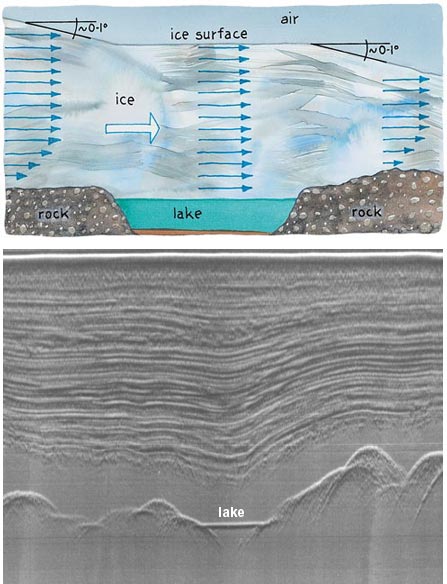
Tom Dunne; Radar image courtesy of Martin J. Siegert.
Although the shape of the basin and the thickness of the overlying ice are fairly well established, glaciologists are harder pressed to state the depth of the water. Indeed, they have estimated the depth of the lake in just two places. The first point of reference, at Vostok Station near the south end of the lake, was established in 1996 through careful examination of Kapitsa's seismic results. Here the water is about 500 meters deep. The second benchmark, at the very northern tip of the lake, is more problematic, because no seismic soundings are available. But my colleague Michael Gorman and I have recently scrutinized various radar profiles and found what we think are signs of radio waves penetrating through, at most, about 10 meters of water before they reflect from the floor of the lake. If we are correct, the northern end must indeed be quite shallow.
Another way to judge the thickness of the lake is to extrapolate from the slope of the surrounding bedrock. For example, the bedrock at the western margin of the lake drops one meter vertically with each 10 meters of horizontal distance to the east. If this steep gradient continues for one kilometer across the lake, the water depth at that point would be about 100 meters (slightly less, if sediments have accumulated). And the downward slope may well continue farther into the lake—just how far nobody knows. Thus the lake is 500 meters deep at Vostok Station, probably several hundred meters deep in the center and relatively shallow at the northern end. From these estimates, one arrives at a rough figure of about 2,000 cubic kilometers for the volume of water contained.
What lies below all this water? Kapitsa's seismic record shows a number of intriguing wiggles that have been interpreted by some as reflections from sedimentary layers draped over the lake floor. This surmise is not unreasonable. The base of an ice sheet typically contains some rocky debris. Ice cores recovered from deep in the Greenland ice sheet, for example, contain an appreciable amount of sediment. So, as the ice positioned just above the waters of Lake Vostok melts, contaminants might drop out and settle to the lake floor.
How fast would these solids rain down on the lake? The rate of sedimentation is related to the amount of material entrained within the ice and to the rate of melting. Kapitsa and his colleagues guessed that only a few millimeters of ice thaw each year. And deep ice cores recovered from near the Vostok station are largely free of rocky material. Thus, the rate of sedimentation within Lake Vostok must be extremely low. Nevertheless, the great age of the lake suggests that several tens (or possibly hundreds) of meters of muck have settled out over time.
Exactly how much time? That depends on the age of the lake, which might be as old as the permanent glaciation of Antarctica, say about 15 million years. But even if the lake has been around that long, the water in it need not be so old. The age of the water, meaning the time since this water first evaporated from the ocean, depends on the age of the ice that melts to form it, which is only around 700,000 years. In any case, the water within the lake is at least this ancient. The actual age depends on how fast new water replaces old. This quantity in turn depends on the rate of melting of basal ice (and freezing of water back onto the bottom of the ice sheet), the amount of downstream drainage out of the lake and the flow of water from upstream into the lake. None of these quantities are known, nor will they be anytime in the foreseeable future. So most geologists interested in Lake Vostok have limited their sights to trying to understand why there is a lake there at all.
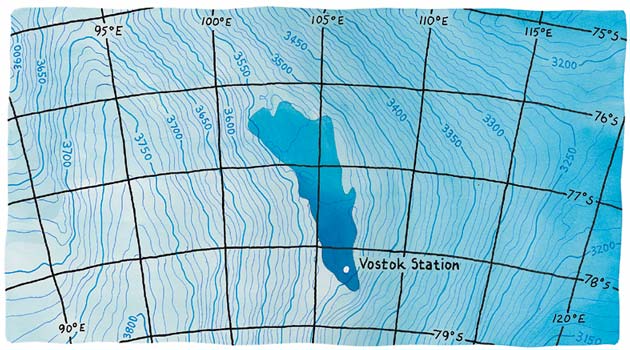
Tom Dunne
The best explanation is that Lake Vostok may lie in a rift valley, as does Lake Tanganyika in East Africa and Lake Baikal in Russia. The geography of Lake Vostok is indeed consistent with this notion, in that the lake has a crescent shape, just like Tanganyika and Baikal, and the side walls of the lake are relatively steep, at least on one side. Rift valleys form where tectonic plates break apart and are often the site of outpourings of lava that has migrated up through the fissures and cracks created in the crust. Some rift valleys lack active volcanism, but nearly all show anomalously large amounts of geothermal heat ebbing upward from the interior of the earth. For Lake Vostok, such warming would be particularly important, because an enhanced supply of heat may lead to the circulation of geothermal fluids through the underlying bedrock, adding both warm water and leached nutrients to the lake.
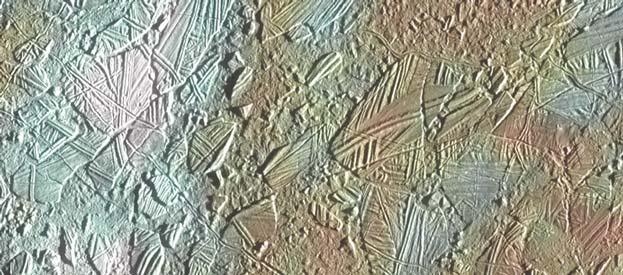
Image courtesy of the NASA Jet Propulsion Laboratory.
Additional life-giving compounds may come from the sediments below and, perhaps more significantly, from the melting ice above. That influx arises because, in addition to the small amount of rocky debris it carries, Antarctic ice also contains gas hydrates—solid deposits of methane trapped within the crystalline structure of the frozen water. So when the bottom of the glacial slab melts, rocky debris and methane are released into the lake. Because freezing onto the base of the ice sheet extracts only pure water, the process of subglacial thawing and congealing should provide a modest but constant source of food for any organisms inhabiting the lake.
Still, no one expects that fish or other large creatures make Lake Vostok their home. The life in Lake Vostok is probably restricted to bacteria, similar to those hardy cells that flourish in other extreme environments. What makes Lake Vostok so intriguing is that these life forms, if they indeed thrive there, must have evolved in isolation from the outside world. Hence many biologists are keen to sample the waters of Lake Vostok and find out.
The difficulty, of course, is in figuring out how to extract water from a lake that is overlain by 4 kilometers of ice. Scientists from the National Aeronautics and Space Administration have recently taken the lead in attacking this problem. Their task is made that much harder by the need to make sure that the pristine lake is not contaminated in any way by the probing. If it were, the extraordinary value of the lake to science could be compromised, or even destroyed, because the integrity of the water samples recovered then and in the future would be thrown into question.
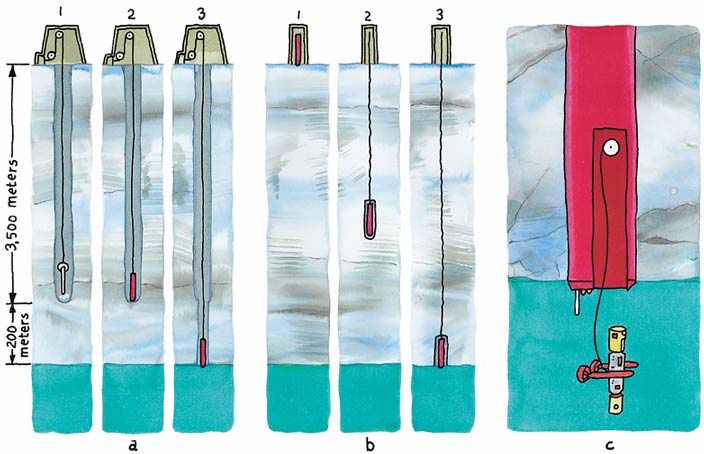
Tom Dunne
Such worries are, in fact, the only impediment preventing the scientific drilling crews who have been working at Vostok Station since 1970 from simply boring through the ice and lowering equipment into the lake. Russian drillers have penetrated to within about 100 meters of the lake. But they wisely have refrained from drilling down farther, in large part because this act would immediately taint the lake with kerosene, the fluid they use to lubricate their drill and to keep the hole above it from freezing.
Clearly, another scheme for lowering scientific instruments into the lake must be worked out. The procedure should allow for measurements to be transmitted from the sensors in the lake to controllers at the surface, and it should be capable of returning water samples. NASA scientists have a clear interest in developing the equipment needed to tackle these problems, because their planned exploration of the Jovian moon Europa will present similar technical hurdles. (Europa has an ice crust that is at least several kilometers thick, with a liquid ocean beneath in which some scientists suspect life may exist.)
Although the details remain to be worked out, it is a good bet that the sampling of Lake Vostok will involve the use of hot water to melt a hole in the ice sheet, one that reaches to within about 200 meters of the lake. After technicians bore into the ice, they would lower a robotic probe that is, perhaps, a fraction of a meter in diameter and a few meters long. This "cryobot" would contain scientific instruments and would be connected to the surface with a cable that carries power downward and information gleaned by the sensors upward. Once positioned 200 meters above the lake, the probe would melt its way down the remaining distance.
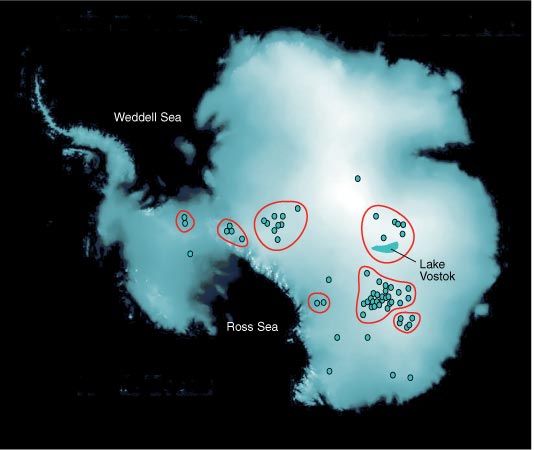
David Schneider
An alternate strategy being considered would use a more capable probe that could melt its way from the surface all the way to the lake. In any case, the cryobot would have to be sterilized, perhaps using hydrogen peroxide, after it melted into the ice. (Unlike other sterilizing solutions, hydrogen peroxide could be broken down into oxygen and water by electrolysis.) Eventually the clean cryobot would reach the lake waters, where it would make measurements. A separate "hydrobot" could also be released into the lake from the main probe, its movement controlled from the surface. This small robotic vehicle could then explore the lake and, perhaps, investigate sediments on the lake floor.
Retrieval of water and sediment samples would be possible if the hydrobot could reconnect to the cryobot, allowing fine materials to be fed upward to the surface through channels in the main cable. But even with the equipment for performing such robotic feats, the retrieval of living organisms may be impossible. Lake Vostok is under high pressure, equal to the weight of the 4 kilometers of ice above it. Microbes from the lake would need to be held in a pressurized capsule if they are to survive the journey to the surface, and, so far, no one has any clear idea how to arrange for that careful handling.
Development of the technology needed to sample Lake Vostok may take engineers several more years. In the meantime, I and other glaciologists working in Antarctica will be studying the lake remotely, trying to fill gaps in our understanding, which to this point is based on just a few airborne radar profiles, one seismic experiment and satellite-based measurements of topography. We will, for example, mount a detailed airborne survey to collect more radar profiles and to augment them with information about the gravity and magnetic fields generated by the bedrock around the lake. In addition, seismic surveys of the area will help gauge the thickness of sediments on the lake floor.
The work will not end there. After all, Lake Vostok is not the only Antarctic subglacial lake worthy of investigation. Since 1996, my colleagues and I have used airborne radar and ERS-1 altimetry to map dozens of other subglacial lakes in Antarctica. Because all this water can, in theory, flow through subglacial cavities and canals, nearby lakes may be interconnected. But such clusters must be isolated from one another by zones where the ice sheet thins and freezes directly to bedrock.
Where the lakes are connected, we would expect to find that microbes migrate. Still, the most upstream lakes in a group will not receive injections and so should preserve whatever unique biology has evolved there, whereas the transfer of water downstream may spread those organisms to other lakes. In any case, biology within isolated clusters will have evolved separately. Thus, there is every reason to expect that many of Antarctica's subglacial lakes, and Lake Vostok in particular, may provide superb natural laboratories for studying the vagaries of biological evolution.
Click "American Scientist" to access home page
American Scientist Comments and Discussion
To discuss our articles or comment on them, please share them and tag American Scientist on social media platforms. Here are links to our profiles on Twitter, Facebook, and LinkedIn.
If we re-share your post, we will moderate comments/discussion following our comments policy.